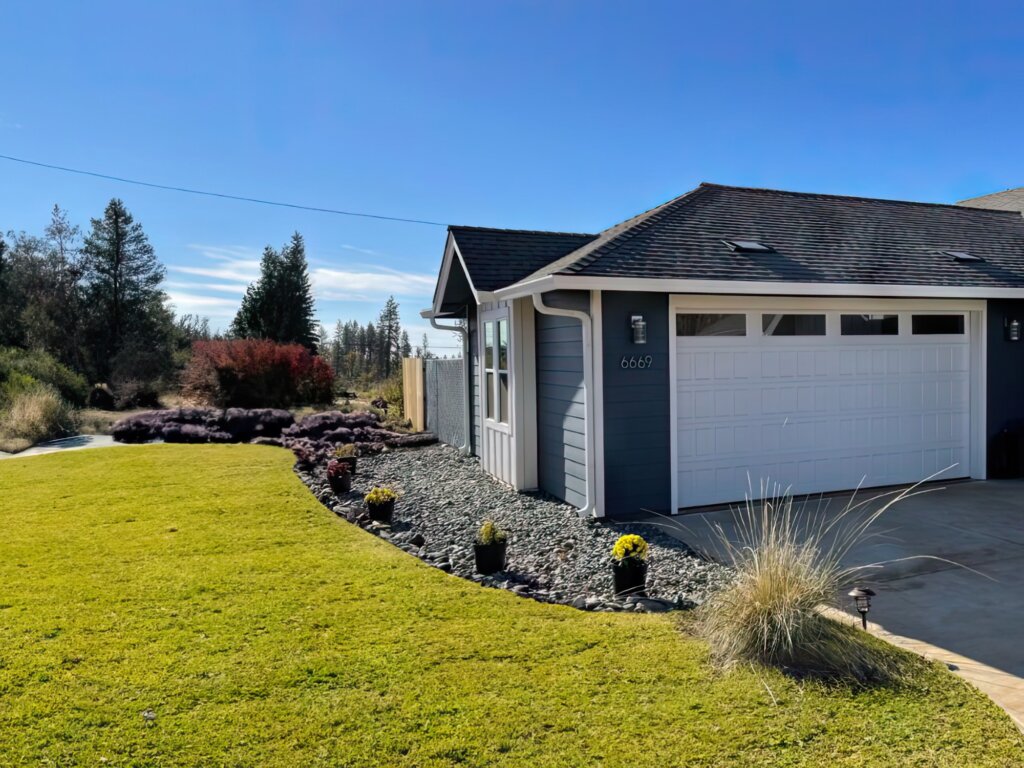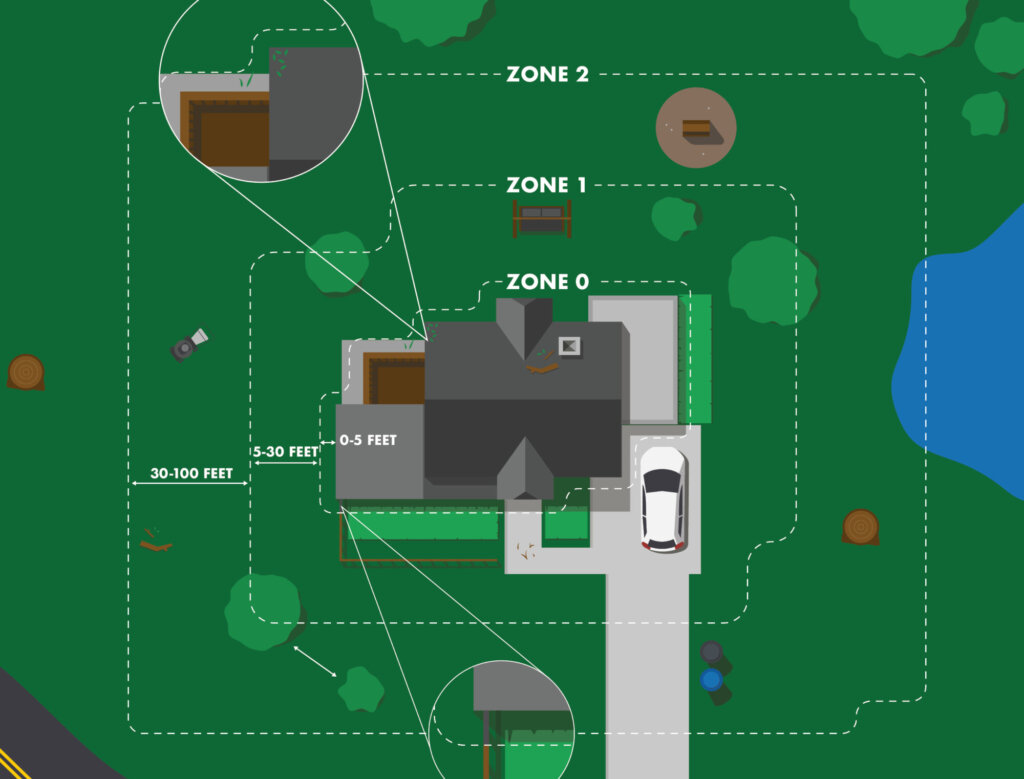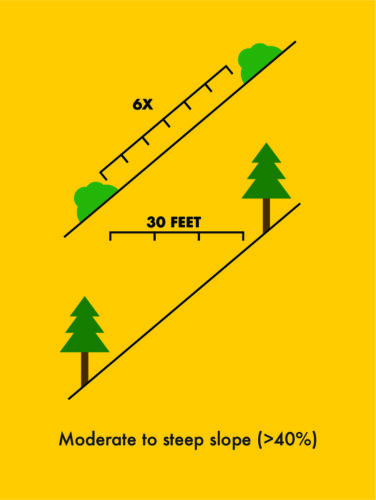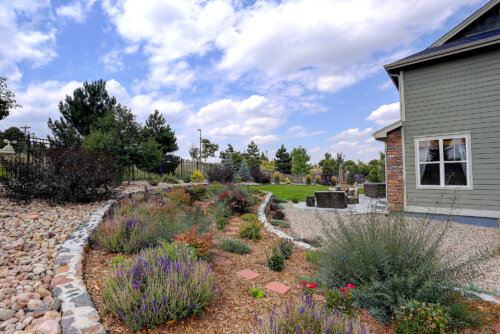Defensible Space
Defend your home against wildfires by creating a safe perimeter.

Your home’s wildfire safety buffer
Defensible space is crucial for your home’s wildfire safety. It’s the buffer zone you create between your property and the surrounding wildland area. This space is key to slowing or stopping wildfire spread and protecting your home from embers, flames, or heat. It also gives firefighters a safer area to defend your property.
About defensible space zones
Defensible space is divided into zones, each with specific guidelines.

In each zone, the intensity of vegetation management increases as you get closer to your home. The goal is to start at your house and work outward, reaching up to 100 feet or your property line.
- Zone 0: Zone 0 extends 0- 5 feet from your home, focusing on intense fuel reduction to protect against ember attacks.
- Zones 1 & 2: These zones cover up to 100 feet around your home. They’re required by law and involve varying levels of vegetation management.
Defensible zone guide
Discover the rules, regulations, and guidelines for creating a safe space around your home.
Zone 0 extends 5 feet from buildings, structures, decks, etc.
While not legally required yet, Zone 0 is key for wildfire defense and preventing fires from spreading to your home. Here are the current guidelines:
- Use gravel, pavers, or concrete instead of combustible mulch
- Clear dead weeds, grass, and debris; check roofs, gutters, and outdoor areas
- Keep branches trimmed 10 feet away from chimneys and stovepipes
- Minimize combustible items like furniture and planters on decks
- Move firewood and lumber to Zone 2 for safety
- Replace combustible fencing and gates with fire-resistant materials
- Shift garbage and recycling containers to a safer area outside this zone
- Relocate boats, RVs, and vehicles away from this zone to reduce fire risks
Zone 1 extends 30 feet from buildings, structures, decks, etc. or to your property line, whichever is closer.
- Clear all dead plants, grass, and weeds
- Remove dead leaves and pine needles from your yard, roof, and gutters
- Trim overhanging branches and keep them 10 feet from your chimney
- Regularly trim trees to maintain a 10-foot gap from others
- Move wood piles to Zone 2
- Prune flammable plants and shrubs near windows
- Clear flammable vegetation and items from under decks, balconies, and stairs
- Maintain space between trees, shrubs, and flammable items like patio furniture and wood piles
- Ensure outbuildings and LPG tanks have 10 feet of clear space to bare soil and no flammable vegetation within an additional 10 feet around them
Zone 2 extends from 30 feet to 100 feet out from buildings, structures, decks, etc. or to your property line, whichever is closer.
- Trim annual grass to a maximum height of 4 inches
- Space out shrubs and trees horizontally (See diagram)
- Ensure vertical spacing between grass, shrubs, and trees (See diagram)
- Remove fallen leaves, needles, and small branches, but can leave up to 3 inches
- Keep exposed wood piles at least 10 feet clear from surroundings, down to the soil
- Ensure outbuildings and LPG tanks have 10 feet of clear space to bare soil and no flammable vegetation within an additional 10 feet around them
- Check local ordinances for defensible space or weed abatement; they may be stricter than state requirements; for example, some areas like San Diego County require 50 feet of clearance in Zone 1
- Consult your local fire department or fire protection district for specific local rules
Plant Spacing
Proper spacing between grass, shrubs, and trees is key in slowing wildfire spread. This spacing varies based on vegetation type, size, and land slope – larger plants on steeper slopes require more space than smaller vegetation on flat areas.
- Trim tree branches up to at least 6 feet from the ground.
- Increase vertical space between shrubs and trees to prevent fire from climbing.
- Use a formula for vertical spacing: Multiply shrub height by 3 for clearance.
For example: A 5-foot shrub near a tree needs 15 feet of clearance to the tree’s lowest branch.

Horizontal spacing depends on the slope of the land and the height of the shrubs or trees. Check the chart below to determine spacing distance.

Fire-smart landscaping
Fire-resistant landscaping involves much more than basic yard maintenance. It combines plant selection and upkeep to help stop fire from reaching your home. With smart planning and regular care, you can create a beautiful, water-efficient, and fire-resistant landscape.
